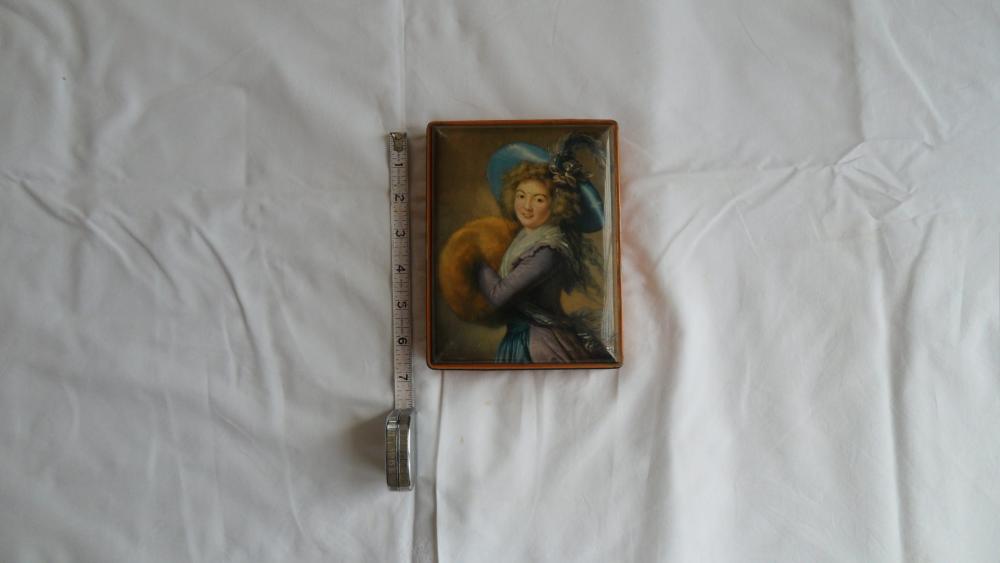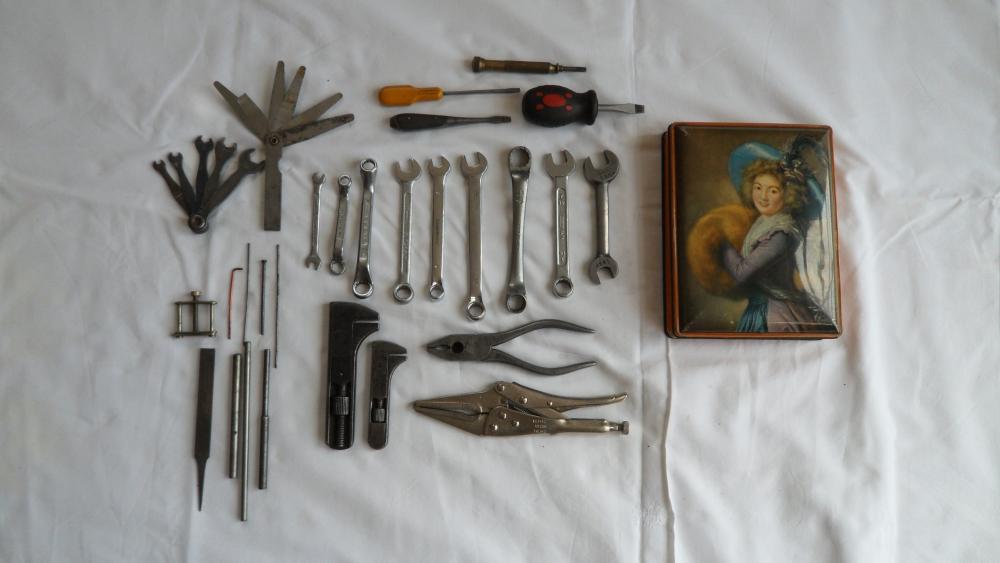Joined: Aug 2017 Posts: 862 Threads: 16
Reputation:
10
Location: North Yorkshire
This is the old toffee tin that I keep under the seat of my Austin 7. Over the years I have found that the contents seem to cope with any adjustment/ minor repair that you might require. I also have a small tool roll with longer screwdrivers, grips, spanners etc but it is quite rare for these to be needed at the roadside.
The contents of the tin include small BSW spanners, BA spanners and some small metric spanners(the Ulster rep has metric fasteners for all non-mechanical bits. Note the selection of bits of wire, metal rod etc. This small tin has helped more than one vintage car (including a Bugatti) keep going in the past.
Under the rear seat I keep two shortbread tins. One has gaskets, sealants, adhesives, wire etc, the other has spares for the carburettor (SU), fuel pump, spare steering arm etc.



Joined: Aug 2017 Posts: 1,257 Threads: 32
Reputation:
28
Location: Cheshire
Car type: Race Ulster, 1926 Special, 1927 Chummy, 1930 Box
Seems about the same as I carry, Malcolm. I think in general, people overestimate what they are likely to need. Just because you can do a job- eg halfshafts it didn’t mean you are going to do it by the roadside.
Alan Fairless
Joined: Aug 2017 Posts: 1,112 Threads: 67
Reputation:
6
My advice is to buy the best you can afford. I pushed the boat out nye on 50 years ago and am still using the same tools. If buying new, avoid such brands as Silverline (IMHO) that will disappoint you at the vital moment. Ebay can be a happy hunting ground - there are always plenty to choose from. A careful purchase of well respected brands (many of which have already been mentioned in this thread) will probably see you right.
As has been suggested by Alan and Malcolm, you dont need a huge set to carry around and (in BSF) 1/4, 5/16/ 3/8 will serve you needs. One or two of each - perhaps - open ended and ring/combination will be ok for most roadside repairs. Larger sizes to hang up in the workshop..
hth...
Joined: Aug 2017 Posts: 389 Threads: 33
Reputation:
5
Location: Garden of England
Car type: ARQ Ruby July 1936
When I first purchased Ruby I bought a new set of Whitworth spanner’s, none fitted.
After some digging around I found information that indicated that dimensions of pre war Whitworth nuts and bolt heads were larger than post war having been reduced in size during the war to reduce steel usage, I believed this to true, but am happy to be corrected.
Joined: May 2018 Posts: 2,799 Threads: 533
Reputation:
20
Location: Peak District, Derbyshire
Car type: 1929 Chummy, 1930 Chummy, 1930 Ulster Replica, 1934 Ruby
16-04-2022, 05:46 PM
(This post was last modified: 16-04-2022, 05:51 PM by Tony Griffiths.)
You may find, as I did the other day, that despite a collection of 23 different "small spanners" not one fitted the tiny nut I was trying to undo. In the end, I made one. I have noticed, over the years, that spanners by Britool are more comfortable to use than those by the other maker of top-class products, Gordon.
Joined: May 2018 Posts: 1,918 Threads: 102
Reputation:
20
Location: Llandrindod Wells
Car type: 29 Special, 30 RK, 28 C Cab
Hi
My favourite spanners are vintage “Bedford” and I have two sets, one in the car and one in the workshop. Their main attribute is that they are thinner than most modern offerings but they also duplicate sizes (ie 1/4 5/16 on one spanner and 5/16 3/8 on the next). More often than not you need to hold the head of the bolt and twist the nut  .
Cheers
Howard
Joined: Aug 2017 Posts: 858 Threads: 47
Reputation:
4
Location: North Wiltshire
Car type: 1927 Chummy, 1926 Top Hat 1938 Big Seven 1/2 a Trials Chummy
(16-04-2022, 05:35 PM)Denis Sweeney Wrote: When I first purchased Ruby I bought a new set of Whitworth spanner’s, none fitted.
After some digging around I found information that indicated that dimensions of pre war Whitworth nuts and bolt heads were larger than post war having been reduced in size during the war to reduce steel usage, I believed this to true, but am happy to be corrected.
Probably because the nuts and bolts holding your car together have been renewed over the years, with whatever the mechanic had in his workshop.
The "change in size" that you refer to is the fact that, after WW 1, better quality steels were available which meant that, where a 1/4" bolt for example, had a 1/4"WW hexagon, this was reduced to the next size down, i.e. 3/16"WW.
After WW2, the government of the day decreed that British Industry should give up its Whitworth and BSF standards and adopt a new "Unified" sizing, which was, in effect, a re-packaged American thread plan. These sizes are the A/F (Across Flats), inch sizes that were used from 1950 - 1970. The Government then inflicted another well thought out change and decreed that, from 1965, British Industry should dump the recently introduced Unified system and adopt ISO Metric threads.
Politicians? What do you expect from a bunch of arts graduates? There's not an engineer among them.
Joined: Aug 2017 Posts: 848 Threads: 22
Reputation:
9
Location: Near Cambridge, UK
Car type: 1928 tourer (mag type), short chassis Gould Ulster
If buying a socket set for Austin Seven work, for most jobs 1/2" square drive are bigger and heavier than you need; 3/8" square drive are better suited for anything up to 3/8" nominal thread nuts and bolts.
Joined: Aug 2017 Posts: 2,748 Threads: 31
Reputation:
95
Location: Auckland, NZ
A schoolmate's father was a duor Pom tradesman. He reckoned the only virtue of NF was that the nuts could be easily split off with a chisel. I found an early 1900s English library book about lathes.The author reckoned the advantage of the American raised V lathe bed was that workers did not sit on it....
NF is mostly distinguishable from BSF but metric is very similar, esp 8mm;5/16. NF is fine for quality as in aircraft but too fine for rough use.
Joined: Aug 2017 Posts: 1,397 Threads: 25
Reputation:
16
Location: North Yorkshire
I have a Britool Socket and open ended spanner set together with an Indian ring set that I've had for many years and is a decent quality. All used constantly. However, the most useful spanner I have is a 5/16" - 3/8" AF open ended that came from a Gordon AF and Metric set that I bought as a present to myself in 1971 when I started my proper full time job. We call it the spanner that fits everything. And it does. The range of things it fits on Sevens is amazing and it's the one spanner I never go anywhere without.
Steve
|









 .
.